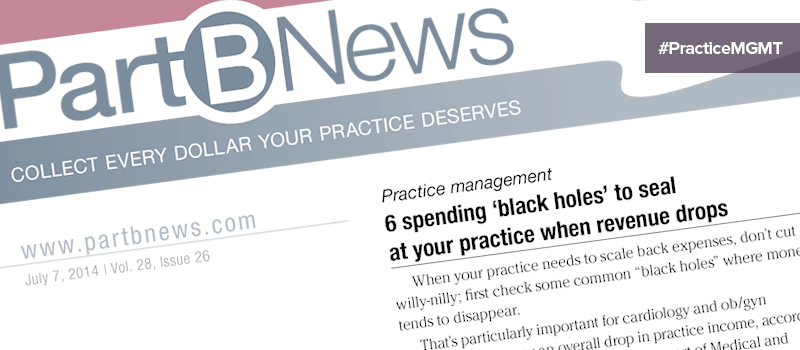LEVO Health CEO, Fergus Linskey was featured in the latest installment from Decision Health’s Part B News where he proposed several practice management solutions to curb spending when revenues drop.
Read the full article from Part B News, titled “Practice Management – 6 spending ‘black holes’ to seal at your practice when revenue drops” below.
Practice management
6 spending ‘black holes’ to seal at your practice when revenue drops
(Featured in Part B News – www.partbnews.com – July 7, 2014 | Vol. 28, Issue 26)
When your practice needs to scale back expenses, don’t cut willy-nilly; first check some common “black holes” where money tends to disappear.
That’s particularly important for cardiology and ob/gyn practices, which saw an overall drop in practice income, according to the recently released Joint Statistics Report of Medical and Dental Statistics on Income and Expenses from the National Society of Certified Healthcare Business Consultants (NSCHBC).
When practice revenue falls, the typical reaction is to try to make more money to close the gap, but “uncontrollable environmental factors” such as increased competition or declining population can make that hole harder to dig out of, says Drew Stevens, a practice management consultant and business coach in St. Louis.
If you can’t bring in more revenue, you have to cut expenses, says David Zetter, lead consultant, Zetter Healthcare Management Consultants, Mechanicsburg, Pa. But NSCHBC’s statistics “reflect exactly what we see in each practice every day — efficiencies and expenses are not being reviewed,” he says.
Review these six black holes where practices lose money and how to fix them:
1. Black hole: Inappropriate staffing. Many physician practices “run a business like a Fortune 500 company,” says Stevens. “When times are good, they hire, and when times are bad, they lay off.” It’s not an efficient way to handle expenses.
Solution: Check industry benchmarks for ratios and costs to see whether you’re in sync with practices that are your specialty and size, suggests Fergus Linskey, CEO of medical consultancy LEVO Group in Tampa. The Medical Group Management Association (MGMA) has that data, for example. If you’re at or below the average, you may not be able to cut without damaging care and efficiency.
Solution: Look for technical innovations to increase efficiency and spare staff. “If you’re spending a lot of revenue on transcription, I would consider a low-cost alternative such as Dragonspeak,” Linskey says. Certain other functions such as billing might be profitably outsourced.
2. Black hole: Empty rooms. Another difficult cut is real estate — typically the second-largest expense. If business is down, you may find you’re paying for space — such as exam rooms — that go unused.
Solution: Cut a new, more advantageous deal with your landlord if you’re renting space in an area with a lot of vacancies, says Joshua Yedvab, vice president of network development for South Nassau Communities Hospital, Oceanside, N.Y.
Solution: Sublet or share space with other providers. “Find someone who’s in the same boat and talk to them about consolidation,” says Yedvab. “You could combine space and even combine on staff functions like billing.”
If you have provider downtime — for example, if you have surgeons on staff who spend days at the hospital or ambulatory surgical center — sublet your staff and facilities to another doctor. “Some providers may want to be in your area but don’t want to invest in their own office just yet,” says Yedvab. You can find candidates in peer-to- peer activities such as hospital rounds or medical society events, he adds.
Solution: Make a big move. “We’re seeing a large population shift to the South, Southwest and Midwest,” says Linskey. “Those areas are underserved. They’re going to have doctor shortages.”
3. Black hole: Employee theft. Some of your money problems might be criminal in nature, says Arthur S. Shorr, owner of Shorr HealthCare Consulting in Rancho Mirage, Calif. In his southern California consultancy, Shorr says he’s discovered a “silent partner” employee, or thief, in one out of five practices.
“Let’s say there’s a loyal office manager who always works late, comes in on Saturdays, has been there forever and everyone trusts her,” he says. “Sometimes it turns out this person is keeping a shadow bank account in the same bank as yours but with a slightly different name or in some other way diverting practice income to themselves.”
For instance, “say you charge Blue Cross $100, and Blue Cross pays $60,” says Shorr. “This employee might take the patient’s cash co-pay or divert receipts from direct billing amount, claiming the patient didn’t pay and then writing it off as a bad debt.”
Solution: Create a policy that no one writes off debts except a partner, says Shorr.
4. Black hole: Payer shortfalls. Insurers don’t always pay the agreed-upon rate, Yedvab says. It often is uncovered only by mistake.
Solution: Payer review. “Whatever you contracted, make sure you get it,” says Yedvab. Review all payments from each payer on your top 10 codes to see that you’re consistently being paid the approved rate, he suggests.
He also recommends practices that use billing services to review their performances to make sure they’re getting good return on denials — another area in which MGMA benchmarks. “If you don’t like the numbers and the service is non-responsive, talk to your colleagues about other services,” says Yedvab.
5. Black hole: High supply costs. Small practices may not be getting the best deal on equipment and supplies.
Solution: Join a group purchasing organization (GPO). Often your local medical society can hook you up, Yedvab says. If not, talk to your local hospitals.
6. Black hole: Costs for liability, malpractice and other insurance. “These costs tend to go up, but reviews are not done on that,” Zetter says.
Solution: Negotiate rates regularly. “We’re reviewing insurance for our clients every other year,” Zetter says. “For one client, we literally just made an adjustment that will save them $95,000 a year.” That could save someone’s job. — Roy Edroso ([email protected])
Resources:
1. NSCHBC Statistics Report on Medical and Dental Income and Expense Averages: www.nschbc.org/statistics/index.cfm
2. MGMA Store — Surveys and Benchmarking: www.mgma.com/store/surveys-and-benchmarking/printed-reports
















